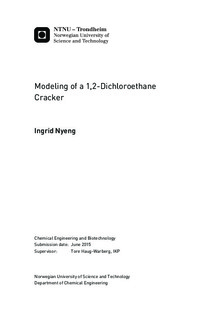Modeling of a 1,2-Dichloroethane Cracker
Abstract
Polyvinyl chloride (PVC) is the second most widely used synthetic polymer plastic, where the largest consumption is in the building and construction sector.PVC is mainly produced through the polymerization of the monomer vinyl chloride (VCM), which is formed through the process of thermal dehydrochlorination (cracking) of 1,2-dichloroethane (EDC). One such cracker reactor is operated by INEOS in Porsgrunn, which is part of their VCM plant at the Rafnes site.Operation of this EDC cracker requires the largest heat input of all the units in the VCM plant, and is thus of special interest with respect to optimization of the plant.
In this study a simulation model for EDC cracking has been developed, which is based on a plug flow reactor (PFR) model and includes coupling of a heat transfer model with a kinetic model. Two kinetic models were implemented; one global kinetic model and one more extensive radical chain reaction model, where important byproducts in addition to one promotor and one inhibitor are included. The extensive kinetic model is based on a reaction mechanism developed by Schirmeister et al., which involves 31 reactions and 24 species. The developed heat transfer model includes radiative and convective heat transfer from the surrounding flue gas in the cracking furnace to the reaction coils.
Simulations were performed with regard to model verification and validation, and to evaluate the effect of temperature, promotor and inhibitor on the cracking process. In general, the developed simulation model is in good agreement with plant data from INEOS. The simulations suggest that an increase in temperature gives an increase in conversion and consequently a larger byproduct formation. A great sensitivity with respect to the feed concentration of the promotor, carbon tetrachloride CCl4, is observed for the extensive kinetic model. With increased inlet concentration of the promotor, the conversion and byproduct formation are increased, while the selectivity is observed to decrease. No clear effect of the inhibitor, 1,1-dichloroethane (1,1-EDC) is detected for the implemented extended kinetic model. The simulations indicate that the byproduct formation in the adiabatic volume (the last part of the reactor) is large, which illustrates the tradeoff between operating at high conversions and production rates of VCM, and maintaining a high selectivity and purity of the product.
